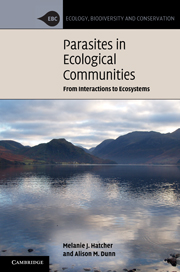Book contents
- Frontmatter
- Contents
- Acknowledgements
- List of abbreviations
- 1 Introduction
- 2 Parasites and competitors
- 3 Parasites and predators
- 4 Parasites and intraguild predation
- 5 Plant pathogens and parasitic plants
- 6 Parasites and invasions
- 7 Ecosystem parasitology
- 8 Emerging diseases in humans and wildlife
- 9 Where do we go from here?
- References
- Index
2 - Parasites and competitors
Published online by Cambridge University Press: 05 August 2012
- Frontmatter
- Contents
- Acknowledgements
- List of abbreviations
- 1 Introduction
- 2 Parasites and competitors
- 3 Parasites and predators
- 4 Parasites and intraguild predation
- 5 Plant pathogens and parasitic plants
- 6 Parasites and invasions
- 7 Ecosystem parasitology
- 8 Emerging diseases in humans and wildlife
- 9 Where do we go from here?
- References
- Index
Summary
Introduction
As long ago as the 1940s, the potential importance of parasites in influencing competition between species had been demonstrated experimentally (Park, 1948). These laboratory experiments, which have now become a classic example in ecology, showed that infection by the shared sporozoan parasite Adelina tribolii reversed the outcome of competition between two species of flour beetle (Tribolium castaneum and T. confusum). When A. tribolii was present, T. castaneum was driven extinct in 66 of the 74 mixed-species cultures. In the absence of the parasite, T. confusum went extinct in 12 out of 18 mixed-species replicates. Park also censused single-species beetle populations with and without the parasite, from which he concluded that the parasite induced higher mortality in T. castaneum, and that this effect was largely responsible for the change in competitive outcomes. This example has become a cornerstone for much of the work on the effects of parasites in communities, illustrating three key concepts that will recur in this book:
(1) Parasites can alter competitive relationships between host species.
(2) By altering interactions such as competition, parasites can play keystone roles in ecological communities. That is, the addition of a parasite species can alter the outcome of an interaction, mediating coexistence or exclusion of one or other host species with knock-on effects throughout the community.
(3) Alternative host species can act as reservoirs for parasite amplification, enabling maintenance of higher parasite population densities, and so providing increased opportunities to infect other species in which the parasite is more virulent.
- Type
- Chapter
- Information
- Parasites in Ecological CommunitiesFrom Interactions to Ecosystems, pp. 20 - 89Publisher: Cambridge University PressPrint publication year: 2011
- 2
- Cited by



